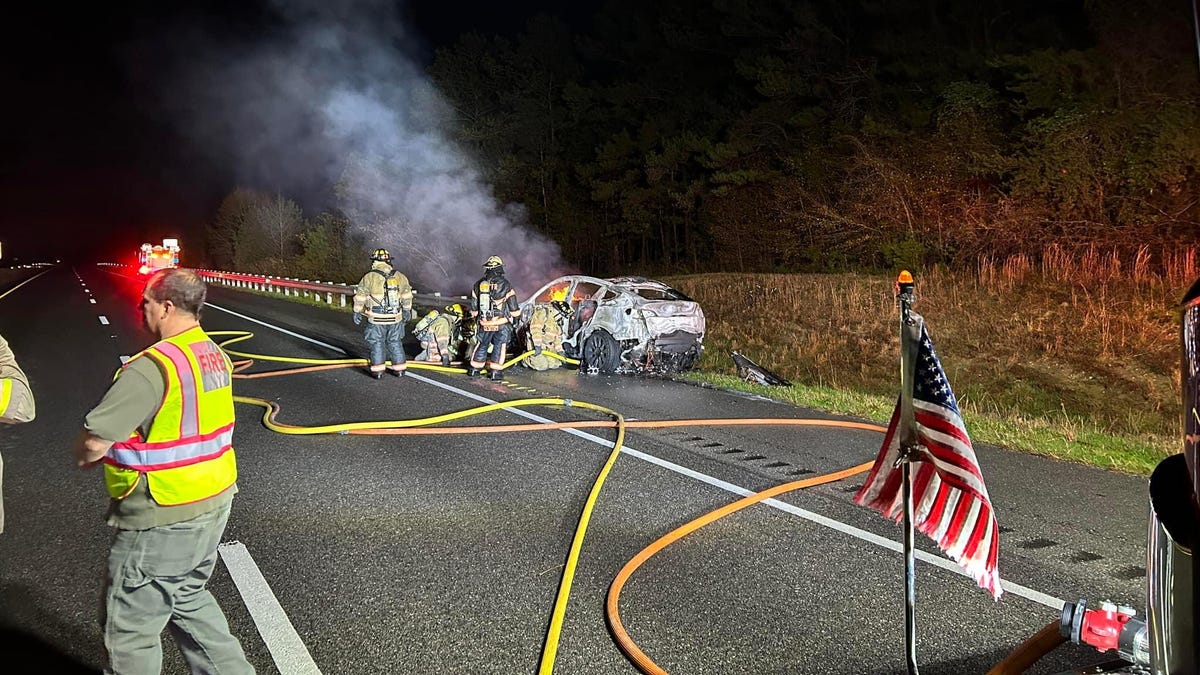A new crash recently in Alabama, but a reminder to something that we all know. Burning Teslas are far more difficult to extinguish than any other car.
It’s pretty clear from the comments that people don’t really know anything about lithium batteries. OP actually knows what their talking about for the most part.
First, lithium batteries contain little to no elemental lithium. Just because the molecule has lithium in it doesn’t mean it’ll react violently with water. Think about table salt. Just because elemental sodium reacts violently with water doesn’t mean table salt will.
Secondly, it’s not an electrical fire. A lithium battery fire is an exothermic, self sustaining chemical reaction.
Thirdly, that chemical reaction is self oxidizing, so you can’t just smother the fire to put it out.
The only way to stop a lithium battery fire is to either let it burn itself out (which is bad because the smoke is highly toxic), or cool it down enough so it can’t self sustain. Water is very good at this.
This is the best comment in this thread. Imo a better option is not to change the cooling fluid, but to have a water connection that allows firefighters to flood the battery instead of just spraying on the vehicle
A giant bucket or water balloon?
Personally I’d go for an aqueduct type system
Perhaps liquid nitrogen or even liquid co2 would be something to try to stop the reaction.
Co2 isn’t liquid on earth. Maybe you’re thinking of supercritical co2, but that turns to gas as soon as it’s released into ambient pressures/temperatures
but that turns to gas as soon as it’s released into ambient pressures/temperatures
Which is what causes it to cool stuff.
It’s not self oxidizing. Old lithium cobalt oxide batteries were, lithium iron phosphate batteries aren’t.
Phosphate will decompose into phosphate ions and oxygen given enough energy. The energy of the P–O bond is greater than Co–O but ultimately means that LFP batteries are also self-oxidizing but less so than lithium cobalt oxide
Reference
Find me any proof of any lifepo4 cells having a self-oxidizing event. Spoiler alert: you can’t, because there’s no reaction that can happen with lifepo4 that will strip oxygen out of phosphate. UL listed companies sell lifepo4 batteries as non-combustible. I highly recommend looking into modern battery chemistry, becase they’re way safer than people think.
There’s plenty of proof in academic literature. FePO4 is quite stable because of the quirks in iron’s valance up to about 500C. But the combination of of lithium skews the valance effects at high temperatures to start losing oxygen at 250C.
Please review the following literature for more information:
- C. Delacourt, P. Poizot, J-.M. Tarascon, and C. Masquelier, Nat Mater., 4, 254 (2005).
- J.L Dodd, R. Yazami, and B. Fultz, Electrochem. Solid-State Let., 9, A151 (2006).
- G. Chen, .XSong, and T. J. Richardson, J. Electrochem. Soc,. 154, 4627 (2007).
How much oxygen are we talking here? I’m guessing not much, as they wouldn’t be allowed to sell lifepo4 batteries as non combustible if they had any real chance of causing a self sustaining fire. So level with me so I don’t have to trudge through a bunch of academic papers: How much oxygen do they mention?
The stoichometry comes out with 2:1 moles of lfp to diatomic oxygen which is significant
The combustibility you’re referring to is a legal definition not a scientific one
FYI Lithium and Lithium-ion are two DIFFERENT battery chemistries entirely. Lithium batteries are primary type cells, meaning not rechargeable (there are some secondary/rechargeable in work currently, but not common yet). You don’t want to put water on a lithium battery due to the lithium metal. However, you typically only find lithium batteries in coin cells (think your watch/fob battery), so big fires are extremely unlikely.
Lithium-ion is a separate chemistry that is a secondary, or rechargeable, type cell. Because the lithium is bonded to a metal oxide (Co-O2, FePO4, NMCO, etc), the lithium is stable and water can be used.
In any case, it’s difficult to use water for EVs because they’re designed to be watertight, so you’re trying to put out a self-sustaining fire/chemical reaction that’s in a box in a box inside several dispersed cells.
This is not an electrical fire, as there’s no sustained voltage. Once the cell fuse pops, you’re only dealing with a single cell internal voltage of 4V (for lithium ion).
I’ve personally burned LFP cells in an inert nitrogen pressure vessel and they very much do burn. They’re “better” than more reactive chemistries like NCA and NMC, but they do still burn (see story of burning teslas). That battery compartment likely has very little air in it, due to the large volume of gas vented during thermal runaway.
Let me know if you have any questions.
I’ve personally burned LFP cells in an inert nitrogen pressure vessel and they very much do burn. They’re “better” than more reactive chemistries like NCA and NMC, but they do still burn (see story of burning teslas). That battery compartment likely has very little air in it, due to the large volume of gas vented during thermal runaway.
This was the tidbit relevant to the most discussion down thread. I appreciate your knowledge! Thanks for sharing your experience.
I should also clarify when I say burn, I mean strap an electrical heater to a battery and observe the response. Heater is meant to represent an internal cell short circuit failure (which is typically cited as leading reason for thermal runaway outside of bad/defective battery design)
What is your job and would one get into that field if one were so inclined. And how much of your job involves setting things on fire for science
I don’t get to set stuff on fire as much as I did in grad school, but I still get to do it occasionally (typically cost, safety, time, etc limitations). I got a degree in mechanical engineering then stayed on to do experimental fire research on lithium ion batteries. Now I help design battery packs that can withstand single cell failures without blowing up completely. Basically I keep a small fire from turning into a big fire. The main trade off is mass/volume of the battery pack, but the latest tech is getting really good in terms of performance.
In grad school, I would’ve tested the hell out of all my ideas. Now, my time is worth something and I have to be smarter about it. Typically model/simulate several ideas, optimize the best of those ideas, then test the best ideas based on preliminary simulation results. Iterate based on test results and so on.
Even the grown-up version of that sounds incredibly cool. Thanks for sharing!
Not a fan of Tesla or the lack of infrastructure the fire departments have on fighting lithium fires (might need to mandate manufacturers fund that tech, resources, and training?) To give an idea of the amount of water that is. An average residential pool 32 x 16 ft (3ft shallow/8ft deep) is 20,000 gallons. So 1.8 pools of water to put it out. I’m not sure what an average gas powered sedan takes to put out when it goes up, but I know water is also not the best choice. I think this just furthers the argument for cheap/free public transportation rather than everyone driving their defacto second living room around.
Europe’s got the right idea.
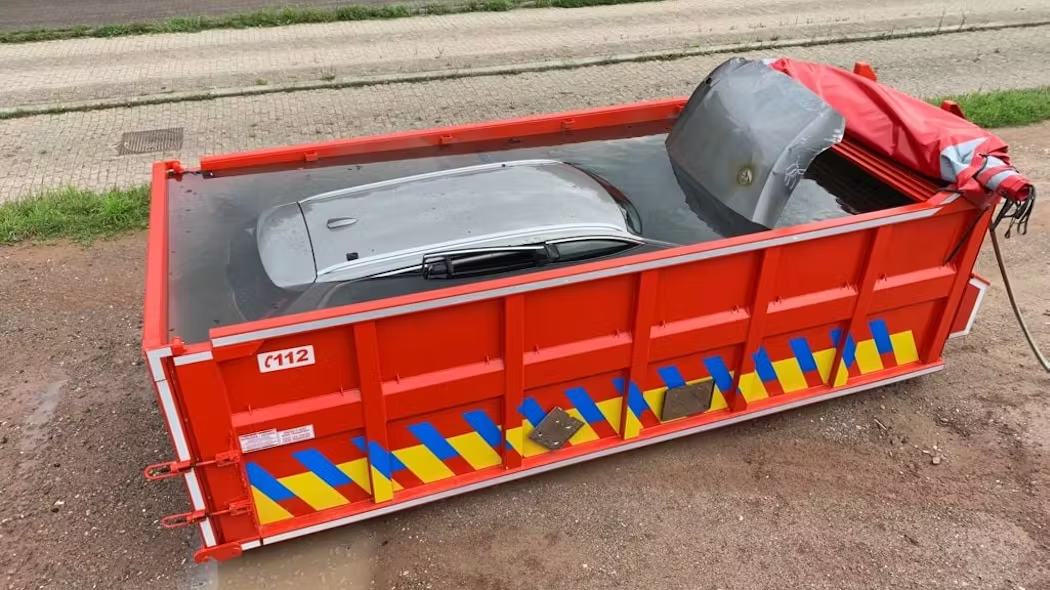
Yeah, its still a ton of water to fill up, but this is far less than the 36,000 gallons used for this Tesla here. We need to start building these containers for the EVs and giving fire departments the right tools for “full submerge” strategies as EVs become more popular.
If the car is on fire already how does this work?
It looks like you would need to drag the burning vehicle into the dumpster and than fill it with water? That doesn’t seem to be a very viable option safety wise.
Different propositions. I think this particular design you hook up a metal cable + winch the car into the container, which has the risks like you point out.
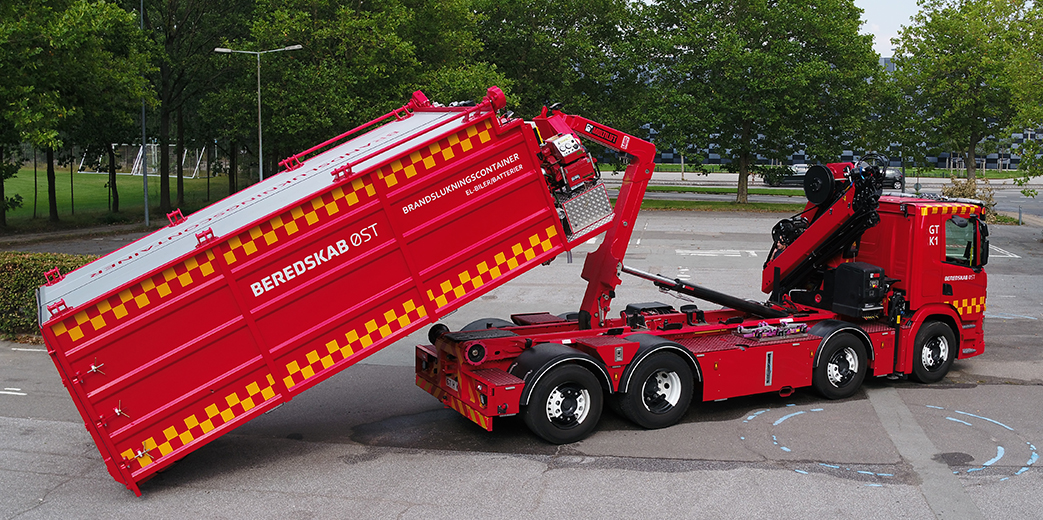
In this design, a truck slams the container from the top down, and then I think like rubber-feet on the bottom try to prevent the water from leaking out. Of course there’s more leakage here, but less so than no container at all. So pros/cons for different methodologies.
The important thing is that these designs are being tested in Europe. USA seemingly has no response yet.
If you’re putting people at risk to sling it up you’re better off just letting it burn. It’s gonna be write off no matter what.
Not gonna be a thing in the USA since it’s dangerous to the people who would be using it. Instead of standing at a distance and using water/foam/sand or just letting it burn.
So there’s basically two phases of an EV Fire.
-
The initial fire, a blazing hot heat that’s dangerous – You just hit it with water from a distance. You’re correct on the analysis here.
-
The “reignitions”. Li-ion batteries, once damaged, will reignite spontaneously for hours after the initial fire. So the fire “has been put out”, but we all know that its only for a few minutes. There’s enough time to winch the car into these containers and fill it up with water in practice.
Its #2 that you’re probably missing. Water / Foam / etc. etc. is only good at stopping phase 1 of the fire. But the next 8+ hours, you need someone to babysit the fire with a hose and keep dribbling water on it before the fire is permanently put out. Or… you know… do like a European and use a container and fill it with water, so it can babysit itself.
Sand and some types of foam prevent #2.
The person would be at risk while rigging it up, you would have to stop spraying while getting it into the box, giving it time to reignite while the person is right beside it.
This is like those fire suppression grenades, great concept, but fails in theory since they are massive safety concerns to go with them.
And it can’t babysit itself, the FD would still be onsite while the vehicle sits in the tub, just let it burn off at that point and than it’s dealt with in a couple hours.
I don’t see Europe actively using these from any research I’ve done, just a few concepts and nothing more. Since it’s a safety concern to be able to use these.
Sand and some types of foam prevent #2.
Do you have a demo of this working? A .pdf report on the amount of sand and/or foam needed to achieve this?
European fire-departments are moving towards this full-submerge tactic because it works. Its one of the big developments in firefighting technique over the last 5ish years.
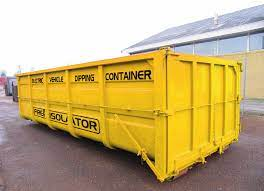
When we’re dealing with 1000lbs / half-ton battery packs, the sizes needed to actually effect these fires grows dramatically. I don’t think that fire-departments will be in the business of carrying dumpsters full of sand to try to extinguish these fires… but I dunno, if you got some numbers on the quantity of sand needed to achieve the suppression of the fire we can compare notes.
Every fire puts a firefighter at risk. That’s not a valid argument. This system does not require a person to stand right next to the fire. That’s why the box is deployed by a mechanical arm.
-
My guess is an electromagnetic crane. This isn’t a good option either. Just use halon fire extinguishers.
My guess is an electromagnetic crane. This isn’t a good option either. Just use halon fire extinguishers.
That’s not helpful.
A Li-ion fire is a runaway exothermic reaction. You need to cool the battery pack below the runaway thermal temperature. Using water to cool the battery-pack and keeping it cool for hours is the best known solution, for now.
If you “only” use a fire extinguisher, you choke out the fire’s reaction, and then 5 minutes later the exothermic reaction just continues (the battery is still hot and self-reacting at this point). The reason why water works is that it finally and sustainably cools the battery below the runaway temperature, and keeps the damaged battery pack below that critical temperature.
You can’t choke the reaction since it’s self oxidizing. Cooling down the reaction is the only way to stop it.
I appreciate the note about the reaction here. Chemistry was my weakest subject back in school. So I’m sure I’m getting lots of details wrong, lol.
But I’ve also watched what fire-departments are doing and read up on whitepapers / discussions on fire-department tactics. So while my chemical knowledge is probably terrible, I at least know what the fire-departments know and discuss.
Yeah, I’ve been vaping for like 12 years now (including building my own devices) and have done a ton of research into battery safety and such, so I always try to correct misinformation on posts about battery fires.
I’m sorry you keep getting downvoted because people don’t know what they’re talking about.
Halon extinguishers won’t work. Lithium battery fires are self oxidizing.
Oh, I didn’t know that. Thanks for the information.
Perhaps using a free radical scavenger in the water might inhibit further combustion of the electrolyte.
https://www.sciencedirect.com/science/article/pii/S2095495620307075
That’s remarkably close to Tesla’s estimates reported in their first responder guide.
No /s club? I had to look it up, lol to make sure…
https://www.tesla.com/sites/default/files/downloads/2017_Model_3_Emergency_Response_Guide_en.pdf
USE WATER TO FIGHT A HIGH VOLTAGE BATTERY FIRE. If the battery catches fire, is exposed to high heat, or is generating heat or gases, use large amounts of water to cool the battery. It can take approximately 3,000 gallons of water, applied directly to the battery, to fully extinguish and cool down a battery fire; always establish or request an additional water supply. If water is not immediately available, use dry chemicals, CO2, foam, or another typical fire-extinguishing agent to fight the fire until water is available
So 36,000 gallons is roughly 1200% more water than in the Model 3 emergency-fire manual, at least.
3,000 gallons of Tesla water, 12,000 gallons of normal water.
Why the hell are they using water on a lithium battery fire??
Because that’s how you put out a lithium battery fire. The fact that the batteries use a lithium based molecule doesn’t mean it’ll react violently with water.
Sodium is highly reactive with water, but table salt isn’t.
Do you think firetrucks have masses of expensive chemicals stored inside of them or something? Fire equipment in the USA is water based. Fire engines have a tank of water that they keep ready + a pump for remote areas, but also a pump to hook into the water-mains if a fire is close to plumbing.
Water works to cool down Li-ion fires and will stop the fire eventually. But it takes a ton of water to do so, mostly because the water dribbles out wastefully. In Europe, they use water still but instead they have:

This prevents the water from dribbling out and actually cools down the battery pack to the point that its safe enough to tow at least. IIRC, the fires can spontaneously erupt over the next few weeks still, but at least the main fire is put out.
Which is why we don’t use water on lithium fires. Fire departments need new ways to extinguish ev fires. Maybe some thick foam or a load of sand to dump over the ev.
Cooling down the reaction is the only way to stop the fires. The chemical reaction is self oxidizing so you can’t smother it.
I’d rather see them contain it with sand or gravel and let it burn itself out rather than waste thousands of gallons of water trying to cool it off enough to stop it. Foam is also an option as is usually used with chemical fires.
The smoke from the fire is extremely toxic, so letting it burn out is a bad idea. Plus, it’s not wasting water, since the water isn’t removed from the environment.
I’m not sure you understand what waste means here. Of course water is never removed from the environment unless it’s sitting in storage containers. I’m going to assume (I know) that you know what I meant and are just being precocious and pedantic.
As for the smoke. Yes it is dangerous but we deal with that all the time with fertilizer plants going up in smoke, trains derailing, etc. Cover the ev with enough sand or other similar material and that will absorb some of the toxic shit, the rest will just go to the sky and hopefully not kill anything flying overhead. Those of us on the east coast literally (and yes I mean literally) just dealt with this earlier this year with the Canadian forest fires. Smoke was making it’s way as far south as the Carolinas and even this far south people with allergies, asthma, etc were feeling it.
As I said. I’d rather see them let it burn itself out. Unless they are using non-potable water that we don’t want to drink or there happens to be a major water source close enough.
They have alternative methods. These folks need to learn how to deal with these. I’m pretty sure other ev fires have had foam or sand of some sort used or you just let it burn. I’d bet this fire department would use water on a grease fire.
Id like to see that… What?! it’s for science
The interwebs has plenty of videos of what happens when water hits a grease fire (if that’s what you are talking about).
I’ve worked with a lot of robots/machines with large lipo and LiFePO4 batteries and as far as I’m aware your best bet is to let it burn and try to prevent the surroundings from catching fire. Using water can make it burn longer.
https://www.youtube.com/watch?v=NeaK9V69Xks
Water does work to suppress Li-ion fires. Its important that we spread this news because many people online confuse Li-element with Li+ ions. They work very differently in practice.
It just takes a LOT more water than you probably expect. But high quantities of water is effective. As Li-ion batteries become more common in our devices (and even vehicles), knowing that water is a usable solution is helpful. We obviously need to develop better tactics than dumping 36,000+ gallons per car fire however.
“NEVER extinguish LiPo batteries with water.”
When in doubt, use a class B fire extinguisher.
So you’ve chosen a lab manual from some small classroom in some university out there.
Sure, lets get into a citation war. My choice of citation is the US Fire Administration. See here: https://www.usfa.fema.gov/blog/ig-062322.html
Listed is many EV manufacturer’s official recommendations for how to fight an EV fire. I’m choosing a large, well respected EV manufacturer. Lets choose Rivian for sake of this argument.
https://www.nfpa.org/education-and-research/emergency-response/emergency-response-guides/rivian
Page 23 of their manual states:
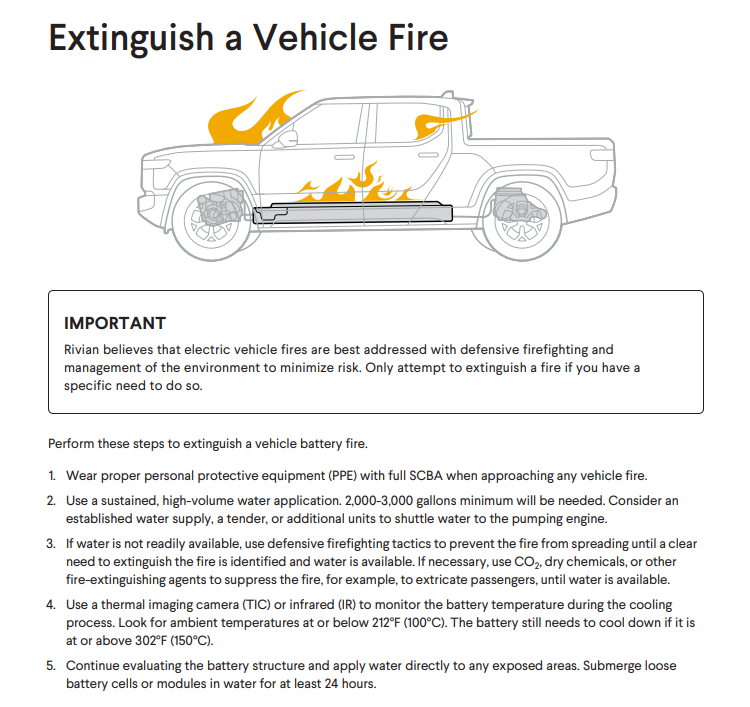
Oh look at that? They say to use thousands of gallons of water (2000 to 3000 gallons for the initial fire), and then work to keep the Li-ion cells below 100C for at least the next 24-hours (which is obviously easiest in what I’ve discussed elsewhere in this thread: a full submerged container). I’ve seen other fire-department manuals recommending 7-days (a full week) of submerged cells just to be sure.
In practice, fire-departments do not have the equipment for that long-term sustained cooling. So they end up baby-sitting the car for like 8+ hours and keep spraying it with a hose every few minutes, wasting tens-of-thousands of gallons of water. Its not the best solution and its a high cost both in water and fire-department’s time, but it does work when a container (or other device) is unavailable.
Step 1 only extinguish if you have specific need to.
They recommend letting in burn unless you must extinguish it actually.
Sure, you win. That was the first result that came up for me on google. If I have a class B fire extinguisher around then I’ll use that before using water.
The problem is that a fire extinguisher only works on the initial flames. If the battery pack remains overheated (as is the case in a large vehicle fire), it will spontaneously combust a few minutes later. This problem is well documented in all the fire-department manuals / discussion on EVs.
So you’re literally spreading misinformation on how to properly fight an EV Fire. I mean, not on purpose or whatever, what you’re saying is a common misconception. But IMO, its in our best interest to spread the proper firefighting tactics across our society so that everyone’s on the same page on the dangers here.
Well, I don’t have an EV and I’m not a firefighter, so EV battery fires aren’t on my radar. If I had an EV and it caught fire I’m not going to try and put it out. The biggest batteries in my life these days are less than 2kWh, so I’m going to use the class B fire extinguishers I bought after I’ve already called the fire department.
Maybe don’t comment on the subject then?
Why are they using water to extinguish an electrical fire? That doesn’t work. The fire department should know that. I’m concerned about the qualifications of the Alabama fire department.
It’s not an electric fire. Lithium battery fires are a self-oxidizing runaway exothermic chemical reaction. The only way to stop it is to cool it down.
Everyone uses water to put out EV fires. Because it does work, it just takes a long time and multiple fire-engines worth of water.
Until someone comes up with a better solution, that’s all we got. I’m pointing out the European solutions in this thread because they seem more feasible (using “only” thousands of gallons, rather than tens-of-thousands of gallons, of water). But water remains the best idea to stop the reaction.
Edit: someone just educated me. Lithium battery fires are self oxidizing. I was not aware of that. My bad!
How is it the best we have?
Deprive the fire of oxygen and it’ll go out. Halon does a fine job of sucking the air right out of the fire.
Did no one on the truck have Google ?
Or pass 9th grade science ?
Li-ion isn’t Lithium. Ions are distinctly different from the raw metal. If this were raw Lithium, of course water wouldn’t work. But this is Li-ion, the chemistry is rather different.
If you passed 9th grade science, you’d remember that Li-ion is Li+, suggesting a dissolved salt in the chemistry. And as you know, Na+ (Sodium+ ion) has completely different chemical reactions than Na (Sodium, aka explodes in water). Na+ in particular, dissolves in water safely. Remember?
Anyway, the Ions are very different from the raw element. As such, its widely accepted that Water is effective, but just barely so. You need lots-and-lots of water to extinguish a Li-ion fire, and the water needs to be applied for hours.

